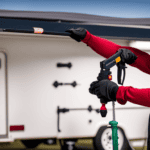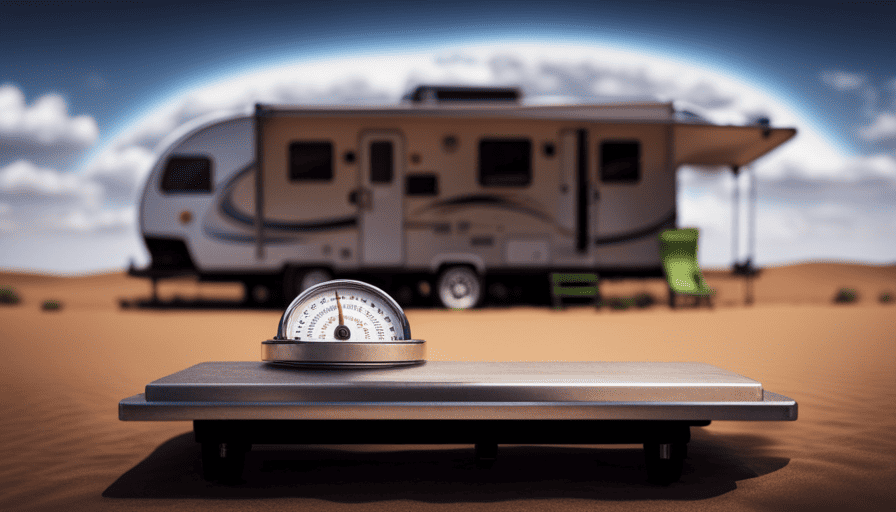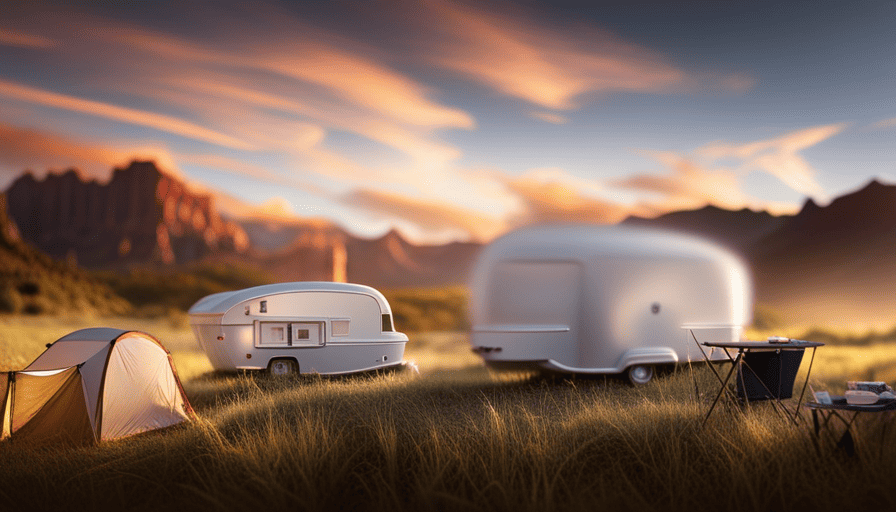When repairing a camper roof, it is important to be mindful of every penny. The saying, ‘a stitch in time saves nine,’ is especially relevant in roof repairs. Therefore, if you observe any indications of damage such as leaks or sagging, it is essential to act promptly.
In this article, I’ll guide you through the process of fixing your camper’s roof, step by step. We’ll start by assessing the extent of the damage and gathering the necessary tools and materials. Then, I’ll share my expert tips on cleaning and preparing the roof surface for repair.
We’ll discuss how to carefully replace or fix damaged roofing material and apply a waterproof sealant for added protection. Finally, we’ll test for any potential leaks and discuss the importance of regular roof inspections and maintenance.
So, let’s get started and ensure a leak-free camper roof that will withstand the test of time.
Key Takeaways
- Immediate action is necessary to prevent further damage to the camper roof.
- Conduct regular roof inspections and maintenance to catch small issues early on and prevent major problems.
- Use the appropriate tools and materials for the repair, such as a ladder, safety harness, roofing cement, caulking gun, and roofing nails.
- Apply waterproof sealant and install flashing and vent covers to protect the roof from water intrusion and extend its lifespan.
Assess the Damage
Take a step back and have a look at the roof to see how much damage has been done. When it comes to fixing a roof on a camper, assessing the damage is the crucial first step. Conduct a thorough roof inspection to determine the extent of the problem and identify any underlying issues.
Check for signs of leaks, cracks, or missing shingles. Look out for water stains on the ceiling or walls inside the camper, as these can indicate roof damage.
Regular roof maintenance is key to preventing major issues and prolonging the lifespan of your camper. It’s important to stay proactive and address any potential problems before they escalate. Inspecting the roof periodically allows you to catch small issues early on, saving you time and money in the long run.
Once you’ve assessed the damage, it’s time to gather the necessary tools and materials. Having the right equipment on hand will make the repair process smoother and more efficient. From sealants and adhesives to replacement shingles or patches, make sure you have everything you need before starting the repair.
With a thorough inspection and the right tools, you’ll be well-prepared to tackle the next steps in fixing your camper’s roof.
Gather the Necessary Tools and Materials
Equip yourself with all the essential tools and materials, like a handyman’s arsenal, to embark on the rejuvenation journey of your camper’s lofty canopy. When it comes to roof repair essentials, you’ll need a few key items to ensure a successful DIY project.
First and foremost, safety should be your priority, so make sure to have a sturdy ladder, safety harness, and non-slip shoes. Additionally, gather a utility knife, roofing cement, caulking gun, roofing nails, a hammer, and a putty knife. These tools will come in handy for removing damaged parts, applying new materials, and securing the roof in place.
Before jumping into the repair process, here are a few tips for DIY roof repair. Start by thoroughly inspecting the roof for any leaks, cracks, or loose shingles. Take note of the extent of the damage and plan your repair accordingly. It’s also important to clean the roof surface before starting any repairs. Remove any debris, leaves, or dirt that may interfere with the adhesion of new materials. This will ensure a smooth and durable repair.
Now that you have all the necessary tools and materials, you’re ready to clean and prepare the roof surface for the upcoming repair.
Clean and Prepare the Roof Surface
Before you begin, make sure to thoroughly clean and prepare the surface of your camper’s roof, allowing for a fresh start and ensuring a flawless repair.
Roof cleaning techniques are essential to remove any dirt, debris, or moss that may have accumulated over time. Start by sweeping the roof with a broom to remove loose particles. Then, use a mild detergent mixed with water to scrub the entire roof surface using a soft-bristle brush. Pay extra attention to areas with stubborn stains or moss growth. Rinse the roof thoroughly with clean water to remove any soap residue.
Importance of roof maintenance can’t be overstated. Regular cleaning and maintenance not only improve the appearance of your camper but also extend the lifespan of the roof. By keeping the roof clean and in good condition, you can prevent leaks and avoid costly repairs in the future. It’s recommended to clean the roof at least twice a year or as needed, depending on the climate and environmental conditions.
Now that the roof surface is clean and prepped, it’s time to move on to the next step: repairing or replacing damaged roofing material.
Repair or Replace Damaged Roofing Material
Now, it’s time for me to assess and address any damage to the material that covers my camper’s roof.
When it comes to repairing or replacing damaged roofing material, there are a few options to consider. The first step is to carefully examine the extent of the damage. If it’s just a few minor cracks or holes, I can opt for a patch repair. This involves applying a specialized patch over the damaged area to seal it off and prevent further water leakage. However, if the damage is extensive or the material is severely deteriorated, it may be necessary to replace the entire section of roofing material.
When deciding between repair options, I also have to consider the cost comparison. Patch repairs are generally more affordable and can be a quick fix, especially for smaller areas of damage. On the other hand, replacing the roofing material may be a more long-term solution, but it can also be more costly.
Once I have assessed the damage and chosen the appropriate repair option, I can move on to applying a waterproof sealant to ensure the longevity and durability of the repaired or replaced roofing material.
Apply a Waterproof Sealant
To ensure the longevity and durability of your repaired or replaced roofing material, it’s crucial to apply a high-quality waterproof sealant. This step is essential to protect your camper from water damage and leaks.
When it comes to waterproof sealant application, there are a few tips you should keep in mind. Firstly, thoroughly clean and dry the roof surface before applying the sealant. This will ensure proper adhesion and effectiveness. Secondly, choose a sealant specifically designed for camper roofs. Some of the best sealant brands for camper roofs include Dicor, Eternabond, and Flex Seal. These brands offer excellent waterproofing properties and are known for their durability.
When applying the sealant, start by using a caulking gun for precise and controlled application. Apply a generous amount of sealant along seams, edges, and any areas prone to leakage. Smooth out the sealant with a putty knife or your finger to create a watertight seal. It’s important to follow the manufacturer’s instructions for drying and curing time.
Once the sealant has dried and cured, you can move on to the next step: installing flashing and vent covers. These components further protect your camper’s roof from water intrusion. By properly sealing your roof with a waterproof sealant and installing flashing and vent covers, you can ensure that your camper stays leak-free and in excellent condition for years to come.
Install Flashing and Vent Covers
After applying a waterproof sealant, it’s important to install flashing and vent covers to further protect your camper’s roof from water intrusion. Did you know that 95% of water leaks in campers are caused by improper flashing installation? By properly installing flashing and vent covers, you can prevent water from seeping into your camper and causing damage.
When it comes to installing flashing, it’s essential to ensure a tight seal around any openings in the roof, such as skylights or vents. This will prevent water from entering through these areas. Additionally, adding vent covers can provide an extra layer of protection against rain and debris.
To help you understand the importance of installing flashing and vent covers, here is a table highlighting the benefits:
| Benefits of Installing Flashing and Vent Covers | ||
|---|---|---|
| Prevents water leaks | Protects against damage | Increases longevity of the roof |
By installing flashing and vent covers, you can avoid costly repairs and prolong the life of your camper’s roof. Once these components are in place, you can move on to the next step of testing for leaks.
In the next section, we will discuss how to test your camper’s roof for any potential leaks without writing ‘step’.
Test for Leaks
After installing flashing and vent covers on your camper roof, the next step is to test for leaks. This is a crucial part of the roof repair process, as it allows you to identify any areas that may still be susceptible to water damage.
To begin the roof inspection, I recommend starting from the inside of the camper. Look for any signs of water stains or discoloration on the ceiling or walls. These can indicate a leak and will help you pinpoint the problem area on the roof.
Next, head outside and carefully climb onto the roof. Take a close look at the areas where you’ve installed the flashing and vent covers. Make sure they’re securely in place and properly sealed. Check for any gaps, cracks, or signs of wear and tear.
To test for leaks, you can use a garden hose or a spray bottle filled with water. Start by spraying water on one area of the roof and then move to another, paying close attention to the areas around the flashing and vent covers. See if any water seeps through or if there are any signs of water damage inside the camper.
By thoroughly inspecting and testing for leaks, you can identify any potential issues and address them promptly. This’ll help prevent further water damage and ensure the longevity of your camper’s roof.
Maintaining regular roof inspections and maintenance is crucial in preventing future leaks and costly repairs.
Maintain Regular Roof Inspections and Maintenance
Make sure you regularly inspect and maintain your camper’s roof to keep it in great condition and avoid any potential issues. Roof inspection is an essential part of camper maintenance, as it allows you to identify any damage or weak spots before they worsen.
By conducting regular inspections, you can catch small issues early on and prevent them from turning into costly repairs. Regular maintenance is equally important, as it helps extend the lifespan of your camper’s roof and ensures its optimal performance.
Here are some benefits of roof inspections and the importance of regular maintenance:
-
Detecting leaks: Regular inspections allow you to identify and fix any leaks before they cause extensive damage to the interior of your camper.
-
Preventing structural damage: By addressing any issues promptly, you can prevent them from spreading and causing structural damage to your camper.
-
Extending roof lifespan: Proper maintenance, such as cleaning and applying protective coatings, helps prolong the lifespan of your camper’s roof.
-
Maintaining energy efficiency: A well-maintained roof helps to insulate your camper, keeping it comfortable and reducing energy consumption.
-
Preserving resale value: Regular inspections and maintenance contribute to maintaining the resale value of your camper.
By regularly inspecting and maintaining your camper’s roof, you can ensure its longevity and prevent major problems. If you encounter any complex issues or are unsure about the best course of action, consider seeking professional help.
Consider Professional Help if Needed
If you’re uncertain about how to address complex issues with your camper’s roof, don’t hesitate to seek professional help. When it comes to fixing a camper roof, there are times when hiring a professional is the best option. While some minor repairs can be done by yourself, certain problems require expertise and specialized tools. So, when should you hire a professional for your camper roof? It’s important to consider professional help if you’re dealing with extensive damage, such as major leaks, structural issues, or if the roof needs to be completely replaced. Professionals have the knowledge and experience to handle these complex issues efficiently and effectively.
Now, you might be wondering how to find professionals who specialize in camper roof repairs. One way is to ask for recommendations from fellow campers or RV enthusiasts. They can provide valuable insights based on their own experiences. Additionally, you can search online for reputable roofing companies or contractors who have expertise in camper roof repairs. Look for reviews and ratings to ensure their reliability and quality of work.
By seeking professional help when needed, you can ensure that your camper’s roof is in good hands. In the next section, we will discuss how to enjoy a leak-free camper roof without any further ado.
Enjoy a Leak-Free Camper Roof
To ensure a worry-free camping experience, it’s crucial to prioritize the maintenance of your camper’s roof and prevent any potential leaks from ruining your trip. Imagine being on a cross-country adventure with your family, enjoying the beautiful scenery and bonding time, when suddenly, a surprise rainstorm hits, and water starts seeping through the ceiling, soaking your belongings and dampening the joyful atmosphere.
To enjoy a leak-free camper roof, it’s essential to take preventive measures and address common roof problems promptly. Regularly inspecting your roof for any signs of damage, such as cracks, tears, or loose seams, is the first step in staying ahead of potential leaks. Ensuring that all vents, skylights, and other roof components are properly sealed can also prevent water infiltration.
Another important preventive measure is maintaining the cleanliness of your camper’s roof. Removing any debris, leaves, or twigs that accumulate on the roof will help prevent clogged drainage systems and water pooling, which can lead to leaks. Additionally, applying a protective coating or sealant specifically designed for camper roofs can provide an extra layer of defense against water damage.
By adopting these preventive measures and promptly addressing any common roof problems, you can enjoy a leak-free camper roof and have a stress-free camping experience. Don’t let a preventable roof leak dampen your adventure; take the necessary steps to protect your camper and create lasting memories with your loved ones.
Frequently Asked Questions
How much does it typically cost to repair a camper roof?
Repairing a camper roof can vary in cost depending on whether you choose to do it yourself or hire professional services. When considering cost, it’s important to do a cost comparison between DIY and professional options.
DIY repairs can be more affordable, but they require time, skills, and materials. On the other hand, professional services may cost more, but they provide expertise, warranties, and save you the hassle.
Ultimately, the cost of repairing a camper roof will depend on your preferred approach.
Can I use regular household tools to fix my camper roof?
Sure, you can use regular household tools to fix your camper roof. However, it’s important to note that camper roof maintenance is crucial to avoid common camper roof problems. According to a study by the RV Industry Association, roof issues are one of the most common problems faced by RV owners. Therefore, it’s essential to regularly inspect and repair any damages to your camper roof using appropriate tools. This will ensure its longevity and prevent costly repairs down the road.
How often should I clean and prepare the roof surface?
I recommend cleaning and preparing the roof surface of your camper at least twice a year to maintain its integrity. Regular cleaning helps remove dirt, debris, and potential contaminants that can cause damage over time.
To prepare the roof, I suggest using roof preparation techniques such as inspecting for cracks or leaks, repairing them promptly, and applying a protective sealant to prevent future issues. This maintenance routine will ensure a well-maintained and long-lasting camper roof.
What are some signs that indicate I need to replace the entire roofing material?
Some signs that indicate the need to replace the entire roofing material include severe water leaks, extensive damage or decay, and sagging or buckling of the roof. These issues can’t be adequately addressed through repairs alone and require a complete replacement.
It’s important to note that roof repair costs can vary depending on the size and type of camper.
How long does it take for the waterproof sealant to dry?
The drying time of waterproof sealants can vary depending on the specific product and environmental conditions. However, on average, it usually takes around 24 to 48 hours for the sealant to fully dry. It’s important to follow the manufacturer’s instructions for the recommended drying time.
If you’re looking for alternative sealants, there are options such as silicone, polyurethane, or butyl rubber sealants that can also provide effective waterproofing for your camper’s roof.
Can the Skills Learned in Shelter Building Help with Fixing a Roof on a Camper?
Learning to master the art of shelter building can indeed be beneficial when it comes to fixing a camper roof. The skills acquired through shelter building, such as understanding structural stability, using appropriate materials, and problem-solving, can transfer to roof repairs. Applying these skills ensures a sturdy and efficient fix for your camper’s roof.
Conclusion
In conclusion, fixing a roof on a camper requires careful assessment of the damage, gathering the necessary tools and materials, cleaning and preparing the roof surface, repairing or replacing damaged roofing material, and applying a waterproof sealant.
Testing for leaks and maintaining regular roof inspections and maintenance are crucial for a leak-free camper roof. If needed, don’t hesitate to seek professional help.
Remember, with proper care and attention, you can enjoy a leak-free camper roof for years to come.



















